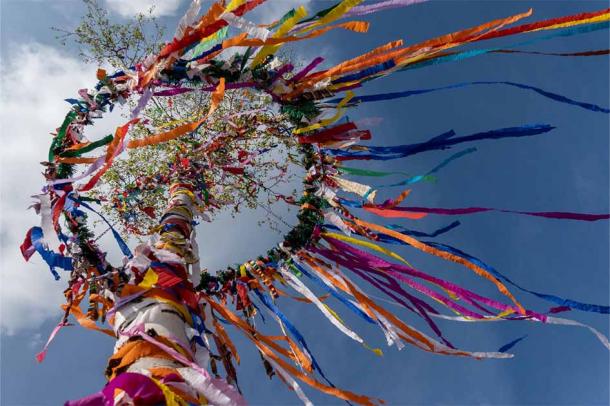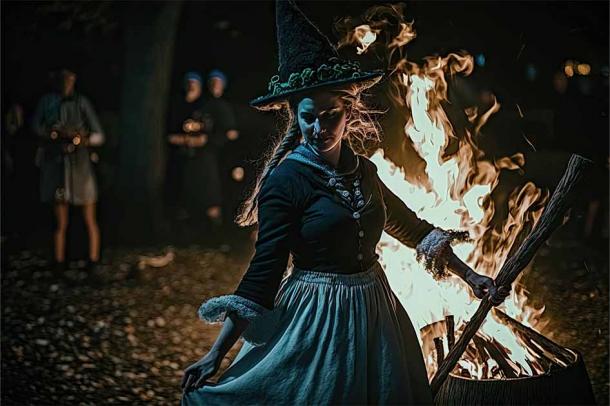
What Are the Similarities and Differences Between Beltane and Walpurgis Night?
Beltane and Walpurgis Night are festivities with deep histories that occur in the springtime, and the two are being celebrated in various European lands this weekend. With fire being a main feature in both, one might be forgiven for thinking they were the same festival with different names. But while the festivals do share many similarities due to their pagan natures, they also have some notable differences, and are actually quite distinct. So, apart from geography, what are the differences in the history and traditions of these two distinctly European festivals?
- Return of the Ancient Gods: The Resurgence of Paganism
- Viking Chief Tore Hund and his successful resistance against Christian conversion
History of Beltane and Walpurgis Night
Beltane is a Gaelic festival that marks the beginning of summer in the Northern Hemisphere. It falls on May 1st and is also known as May Day. Beltane has its roots in Iron Age Celtic culture, where it was celebrated as the time when the goddess of the earth, known as the May Queen, was reborn. The festival is still celebrated today in many parts of Scotland, Ireland, and Wales, as well as by modern-day pagan communities, and is one of the four main festivals on the Pagan Wheel of the Year in those countries. Although held in mid-spring, is a welcome to the summer season.
Walpurgis Night, also known as Walpurgisnacht, is a traditional Germanic festival that takes place on the night of April 30th. The festival is celebrated in many parts of Germany, Austria, and Scandinavia, and is named after Saint Walpurga, a Christian missionary who lived in the 8th century and whose remains were transported to the Church of the Holy Cross at Eichstätt on May 1st, when she was canonized. The association with Walpurga pretty much ends there, although there are other Christian elements that have been brought into a festival's that is believed to originally have been a celebration of the arrival of spring and the return of fertility to the land.
- Aine: Radiant Celtic Goddess of Love, Summer, and Sovereignty
- Faith or Economy? Why Pagan Religions Lost Their Position in Europe

Image of the crowd on Walpurgis Night at the Thingstätte on the Heiligenberg in Heidelberg. (CC BY-SA 2.0)
Traditions of Beltane and Walpurgis Night
Both Beltane and Walpurgis Night are celebrated with bonfires, dancing, and feasting. These traditions reflect the ancient pagan belief that fire and light have purifying and protective properties. People would (and still do!) leap over the fires or walk around them clockwise to bring good luck and drive away evil spirits.
In some parts of Scotland, young men and women would perform the Beltane Fire Dance, where they would hold hands and dance around the bonfire, weaving intricate patterns. The dance was a symbol of the cycle of life, death, and rebirth, and it was believed to ensure fertility and abundance for the coming year.

Beltane Fire Festival Red Man dancing. (SixSigma/CC BY 3.0)
Similarly, in Germany and Scandinavia, people would light bonfires and dance around them to celebrate the arrival of spring. Here, it was also said to be a time when witches and other supernatural beings would roam the earth, and people would make noise and light fires to scare them away.
Another common tradition of Beltane and Walpurgis Night is the use of greenery and flowers. In Celtic culture, the May Queen would be adorned with a garland of flowers, and people would decorate their homes with branches and flowers to bring good luck and fertility. Similarly, in Germany and Scandinavia, people would gather wildflowers and greenery to decorate their homes and maypoles.

A German maypole with decorations of flowers and ribbons. (mhp/Adobe Stock)
The maypole is another tradition that is common to both Beltane and Walpurgis Night. It is a tall pole decorated with ribbons, flowers, and other ornaments, and it symbolizes the phallus, the male principle of fertility. In Scotland and Ireland, the maypole is called the May Bush, and it is decorated with flowers and ribbons and placed outside homes.
Differences between Beltane and Walpurgis Night
While Beltane and Walpurgis Night share many similarities, there are some differences in the way they are celebrated. For example, Beltane is primarily a Gaelic festival, while Walpurgis Night is more commonly celebrated in Germany and Scandinavia.
Beltane is also associated with the goddess of the earth, while Walpurgis Night has Christian overtones and an association with witches. (Christians often associated pagans with witchery, after all.) As a result, Walpurgis Night has a darker, more supernatural feel than Beltane.
In German folklore it is said that witches from all over the land would gather for a great sabbath on top of the Brocken (also known as the Blocksberg), the highest peak of the Harz mountain range. It is thus partly more reminiscent of a Halloween-like tradition than a spring celebration.
While both incorporate fire into their traditions, the significance is very different.
The Beltane Fire Dance celebrates the ‘return of the sun’. The ancient Celts believed the sun was held prisoner during winter months only to be released each spring to rule the summer sky and they celebrated this mythic release with fire ceremonies and a huge feast to mark the occasion. And although there might have been more historic reasons for the use of fire, Walpurgis Night is now celebrated with the lighting of bonfires and the making of noise to scare away evil spirits and witches. It seems that the true pagan roots might have been changed to incorporate more Christian beliefs.
A final difference between the two festivals is their timing. Beltane falls on May 1st, while Walpurgis Night is celebrated on the night of April 30th. This difference in timing reflects the different pagan calendars used in Celtic and Germanic cultures.

AI generated image of a stereotypical witchlike woman dancing near the fire, the supposedly pagan holiday of Walpurgis night (DyrElena/Adobe Stock)
Modern-day celebrations of Beltane and Walpurgis Night
As already indicated, today, both Beltane and Walpurgis Night are celebrated by modern-day communities around the world. These celebrations often include traditional rituals, such as lighting bonfires, dancing around maypoles, and making offerings to the earth.
In Scotland, the modern Beltane Fire Festival is a popular event that takes place on Calton Hill in Edinburgh. The festival includes a procession of the May Queen and the Green Man, as well as performances of the Beltane Fire Dance and other traditional rituals.
Similarly, in Germany and Scandinavia, Walpurgis Night is celebrated with bonfires and parades. In Sweden, it is known as Valborgsmässoafton, and it is a public holiday and also includes the singing of traditional songs.
In addition to these traditional celebrations, Beltane and Walpurgis Night have been incorporated into modern-day popular culture. For example, the pagan themes of Beltane have been featured in movies, TV shows, and music, such as the classic horror film The Wicker Man and the TV series Game of Thrones. Similarly, the spooky and supernatural aspects of Walpurgis Night have been featured in horror movies, such as the Swedish film Let the Right One In.
In conclusion, Beltane and Walpurgis Night are two ancient festivals that share many similarities, including the use of bonfires, maypoles, and greenery, as well as a focus on the arrival of spring and the renewal of the earth. However, there are also some notable differences between the two festivals, such as their origins, their timing, and their focus. Today, both Beltane and Walpurgis Night are celebrated by modern-day pagan communities as well as those just enjoying a general celebration.
Top image: Left; May Queen at Beltane Fire Festival 2010 – Edinburgh. Right; Walpurgisnacht (Walpurgis Night) by Falero. Source: Left; Martin Robertson/CC BY-NC-ND 2.0, Right; Public Domain
By Gary Manners
References
"Beltane Fire Festival - Beltane". Beltane Fire Festival. Retrieved April 29, 2023, from https://beltane.org/beltane-fire-festival/
"Walpurgis Night - Celebrating the Arrival of Spring". German Culture. Retrieved April 29, 2023, from https://www.german-way.com/travel-and-tourism/festivals-and-holidays/walpurgis-night/
"Beltane: May Day Festival". History.com. Retrieved April 29, 2023, from https://www.history.com/topics/holidays/may-day-1
"Valborgsmässoafton". Wikipedia. Retrieved April 29, 2023, from https://en.wikipedia.org/wiki/Valborgsm%C3%A4ssoafton
"Beltane and Walpurgis Night: The Differences and Similarities Between Two Spring Festivals". Learn Religions. Retrieved April 29, 2023, from https://www.learnreligions.com/beltane-and-walpurgis-night-2561616
"The 10 Best Walpurgis Night Scenes In Horror Movies". Screen Rant. Retrieved April 29, 2023, from https://screenrant.com/best-walpurgis-night-scenes-horror-movies/















